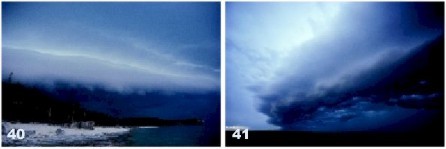|
PREV NEXT

38-39 NW/E A severe multicell storm is dropping large
hail but little rain in this dry, western airmass. Despite the widely-spaced
flanking line towers, the storm remains intense and cohesive. It also has a
high-based wall cloud that looks like a tiny step below the main base. A closer
look in 39 shows a circular swirl, suggesting rotation of the small but potent
updraft core. This storm rolled along almost at right-angles to anvil motion
for hours and produced a tornado later in the day.
Gust fronts and wind squalls
Although very strong winds can occur inside the rain core if a downburst has
just reached the ground, most cases of damaging wind are just ahead of the core
and can be identified by their special cloud features.
A downburst is a concentrated, severe downdraft which accompanies a
descending deluge of precipitation and induces an outward (horizontal) burst
of damaging wind at the surface. The leading edge of this wind squall is the
gust front, along which a great variety of cloud features is seen. Advancing
cold air acts like a plow, scooping the warmer air upward to form a dramatic
shelf cloud on the forward edge. The shelf often has a laminar or banded surface
and black, turbulent base. New convection can be generated within this cloud,
causing brief heavy showers, but the main rain core is still to come. If the
shelf pushes too far ahead, it will slow down, decrease in size, and sometimes
become detached as a roll cloud. Very humid conditions will promote a
thick, low cloud bank that approaches quickly, sometimes emerging from the haze
with little warning. In drier regions the shelf is not as low or dark and the
rain can be seen behind it.
A sharp, strong gust front will cause the lowest part of the leading edge to
be ragged and lined with rising scud. In a severe case there will be vortices
along the edge, which you can see as twisting masses of scud that may reach
to the ground or be accompanied by rising dust.An extreme example of this phenomenon
looks almost like a tornado and is known as a gustnado (see page 40).
A very low shelf cloud accompanied by pockets of dense,rising scud and/or blowing
dust is the best indicator that a potentially violent wind squall is approaching.

40 NW/SE, 41 SW/E Two gust fronts
with the low, ragged shelf clouds typical of humid regions. The forward edge
is smooth and banded but becomes turbulent farther back. In 40, very heavy rain
follows the gust front by a minute but in 41 a gap of lighter sky as formed
from subsidence in the wake of the advancing outflow. Note how the lowest clouds
relect warmer skylight (yellow-rust tones) which contrast with the dark, blue-green
hues near the rain core. (Pale blue-green hues result when light from above
is filtered through a tall storm cloud, causing the "green sky" effect.)
PREV TOP NEXT
Created :
2002-08-26
Modified :
2002-12-19
Reviewed :
2002-12-19
Url of this page : http://www.msc.ec.gc.ca
/education/severe_weather/page19_e.cfm

The Green LaneTM,
Environment Canada's World Wide Web Site.
|